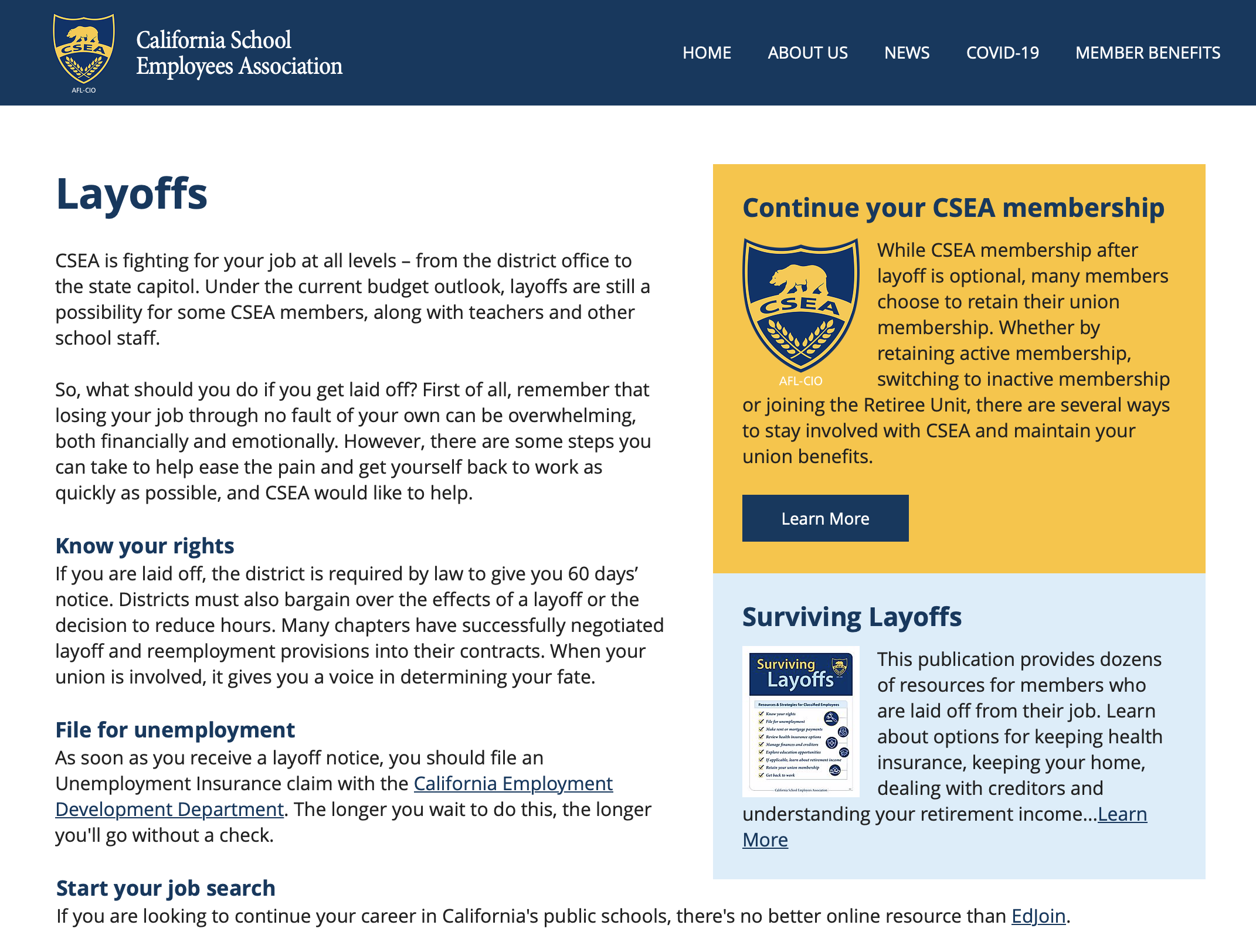Understanding layoffs
Fighting for job security during a pandemic
CSEA has a proud history of fighting for our members’ jobs at all levels – from the district office to the State Capitol.
Recently, CSEA played a significant role advocating for classified jobs in the State Budget negotiations. Thanks to CSEA and our allies at the Capitol, the budget includes "legislative intent language" that states all classified staff should be retained. Additionally, the budget prohibits layoffs and releases without cause for permanent and probationary employees in three sets of classifications: nutrition, transportation and custodial.
While many districts are supportive of their classified staff, some districts with poor financial management or adversarial relationships with their employees may target classified jobs as a means of balancing long-standing deficits, using the current pandemic to justify everything from furloughs and salary freezes to benefits cuts and hiring freezes. And despite this year’s state budget that provides the same level of education funding as last year with the legislative intent language stating the contrary, some districts have begun issuing layoff notices.
Recently, CSEA played a significant role advocating for classified jobs in the State Budget negotiations.
Fighting for job security during a pandemic
CSEA has a proud history of fighting for our members’ jobs at all levels – from the district office to the State Capitol.
Recently, CSEA played a significant role advocating for classified jobs in the State Budget negotiations. Thanks to CSEA and our allies at the Capitol, the budget includes "legislative intent language" that states all classified staff should be retained. Additionally, the budget prohibits layoffs and releases without cause for permanent and probationary employees in three sets of classifications: nutrition, transportation and custodial.
While many districts are supportive of their classified staff, some districts with poor financial management or adversarial relationships with their employees may target classified jobs as a means of balancing long-standing deficits, using the current pandemic to justify everything from furloughs and salary freezes to benefits cuts and hiring freezes. And despite this year’s state budget that provides the same level of education funding as last year with the legislative intent language stating the contrary, some districts have begun issuing layoff notices.
Recently, CSEA played a significant role advocating for classified jobs in the State Budget negotiations.

Resources and Assistance
CSEA offers strategies and resources for you to help protect yourself and your family in the event of a layoff. Learn more about health insurance options, keeping your home, dealing with creditors and understanding your retirement income. You can also keep your union membership after getting laid off. Choosing this option provides you with access to important benefits and services, including access to CSEA’s Free and Low-Cost College Programs.
Know your rights
There are only two reasons classified employees can be laid off: “lack of work” and “lack of funds”. If you are laid off, the district is required by law to give you 60 days’ notice. The law also mandates that layoffs occur by seniority within a single classification on a district-wide basis. In most cases, the last hired is the first laid off within a classification. Some contracts determine seniority by date of hire as opposed to hours worked.
If a district eliminates positions and lays off employees, it may try and shift their duties to other employees. However, there are restrictions that govern what the employer can do as far as transferring duties to other employees. If you are asked to take on the work of a laid-off employee, talk to your CSEA representative immediately.
Bargaining the effects of layoffs
Districts must bargain with the union over the effects of a layoff or the decision to reduce hours. Many CSEA chapters have successfully negotiated layoff and re-employment provisions into their contracts. When your union is involved, it gives you and your colleagues a voice in determining your fate.
In worst-case scenarios, laid-off workers are unable to get another position in the district and become unemployed. Again, these workers still have rights: unemployment insurance and re-employment status to name a few.
Get involved to fight layoffs
There is strength in numbers and power in solidarity. CSEA encourages all members to be active in their chapters and stay informed of CSEA’s response to new district policies and decisions. While we are all doing our best to make schools function the best they can in these difficult circumstances, we must continue looking out for the rights of our CSEA brothers and sisters. Please connect with your chapter to learn more about what’s going on and what you can do to get involved.
Layoff terminology:
Re-employment status Re-employment status means that the district must re-employ a laid off worker who is qualified to fill a vacant position in the district rather than hire someone new.
Seniority The California Education Code defines seniority for layoffs by the number of hours you’ve worked within a classification. The employee with the shortest length of service would be laid off first. However, many CSEA chapters have negotiated with their employer to define seniority by date of hire within a classification.
Reasonable Assurance The Unemployment Insurance Code requires the district to send all classified employees who work less than 12 months per year a notice stating the likelihood of returning for the next school year.
Unemployment Insurance The California Employment Development Department (EDD) offers unemployment benefits. The EDD is responsible for determining a worker’s eligibility for unemployment insurance and paying unemployment benefits. To collect benefits, you must file a claim with the EDD. The longer you wait to do this, the longer you'll go without a check.

